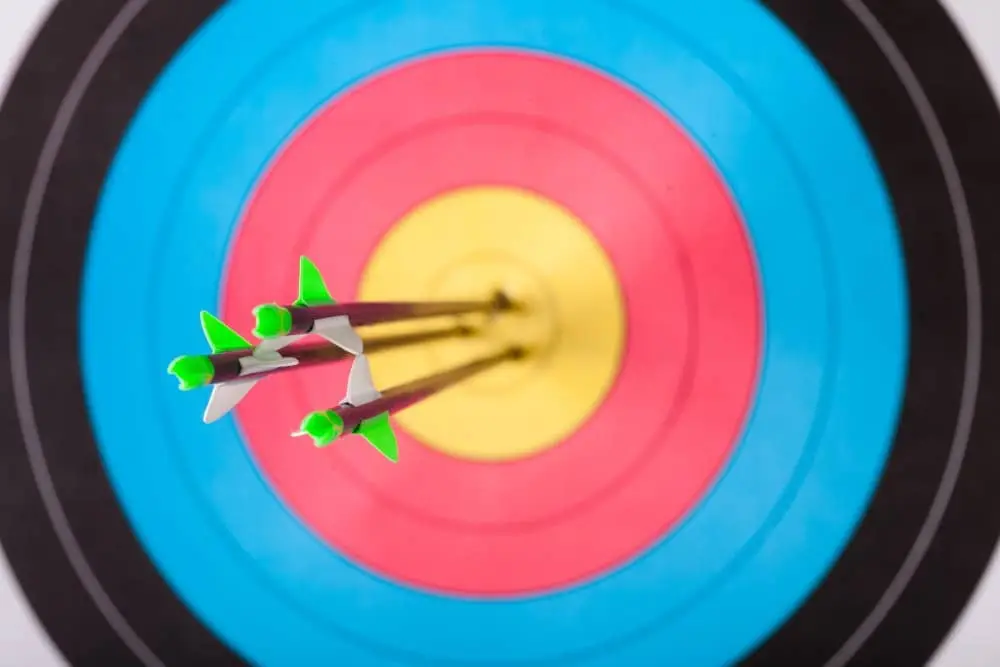Note: Our site links to archery and bowhunting products sold by outside vendors, and we may earn a small commission if you purchase an item after clicking one of these links. Learn more about our affiliate program.
A bow isn’t much good without something to shoot at, so in this post, we’ll go over the different targets that archers can use, along with some of the pros and cons of each type.
After you’ve gone through the post and you know the types of archery targets out there, you can hop over to our recommended archery targets post and see if there’s anything that strikes your fancy.
We’ll start with the most identifiable target, and the one we’re all most familiar with:

Traditional Bulls-Eye Style Target
These are, perhaps, the most identifiable symbol of archery—the circular rings of a competition target: first white, then black, then blue, then red, then yellow at the center (yes, yellow—if you ask a lot of people, they’ll tell you it’s red at the center. It’s not. That’s a common mistake).
You’ve seen these everywhere: at the range, at camp, probably even in your friend’s yard. They’re synonymous with target shooting, and there’s a reason why: they’re a fantastic way to measure accuracy. If your ultimate target is the “X” in the middle of the target, an arrow in each ring outside of that center point tells exactly how far away you are from your target. The rings provide a great way to score archery competitions, and they’re great for newbies.
Plus, from a practical standpoint, the bullseye is your ultimate goal. Each ring is basically “a degree of miss,” and that’s why bullseye targets are so fantastic to use when learning archery: you can see your progress in very concrete terms. When your arrows are spread all over the target, you need to do some practice; when they’re clustered in the red and yellow, you know you’re improving. Studying your own progress can be a little difficult on other types of targets.
3D Targets / 3D Archery Targets
These are targets that look like particular types of game: deer, turkey, elk, and so on. They’re life-saved (or close to life-sized) and they can get a little fancy, but they can be worth the investment: they’re designed help train hunters to hone in on the vital organs of a game target, and accurately hitting vital organs of a live game target is Job #1 for a hunter.
If you look at a 3D target, the good ones will have an outline of the heart and lungs, and hunters need to practice their skills to make absolutely sure they can accurately and reliably hit those areas. Learning to aim at and hit vital organs so game does not suffer is a big part of being a responsible hunter, so if you plan on heading out to the woods to track some game, they’re an option you may want to consider.
Bags and Bag Targets
Next up in our “types of archery targets” post are BAGS. These are a fantastic option, and one of their main features is that they’re transportable. You can keep them in the garage, throw them in the pickup, drag them around the yard (if, of course, your local laws allow you to have a target in your yard—check and be sure!). They’re durable, usually weather-proof, and they’re a great substitute for traditional bull’s eye targets, which often require a stand.
They’re usually a little smaller than traditional targets, and that’s the down side—if you’re new to archery, or if you’re still having a tough time grouping arrows, the surface area on a bag will be a little bit smaller, so you may have a couple of misses for every end you shoot. And, even if you’re on your way to great accuracy, they’re a little tougher to use for long-distance shooting. If you’re going to do longer-distance shooting, or even just shoot slightly past your usual range, a smaller target may pose some problems.
But, most of the time, that’s fine. Bag targets are REALLY popular—they’ve come a long, long way over the last decade or two—and for many archers, they’re the best archery target on the market. There are some fantastic models out there, and we recommend them if you’ve developed some archery skills.
Cubes / Block Targets
These are usually dice-shaped targets, and in some cases (like the Rinehart 18-to-1 target), they’re further shaped so that instead of having six sides (like dice), they have 18 sides. The main advantage of cubes is that you can shoot them from different angles—which is great practice for hunters, who may let off shots from tree stands or weird vantage points. That’s a real “pro” to a model like the Rinehart we just mentioned—because it has so many sides, you can rotate around it and have plenty of flat surfaces to practice on.
In a perfect world, hunters would practice on both 3D targets and cubes. The 3D targets allow them to develop their skills on a target that looks like actual game, and a cube allows them shoot from various positions around the cube. Plus, a cube can allow you to use broadheads, so you can tune your broadhead arrows and make your practice even more closely like a hunting scenario.
These are usually a little bit lighter and easier to lug around, and made of foam. Because they veer to the lighter side, they may shuffle around a little bit as you shoot arrows into them—it’s not uncommon to see them shift position a little bit. That may be a little odd to imagine, but say you shoot a number of arrows into the left side of the cube, that left side of the cube may move back an inch or two or three. It’s not a big deal—we think it’s actually a good thing, because it introduces a “dynamic” aspect to the target—but it’s something to keep in mind.
Archery Targets: A Summary
So, there you have it! Your options are basically round bullseye targets, 3D targets in the shape of game (or dinosaurs, etc.), bag targets, and cube/block targets.
We hope that helps—good luck, have fun, and safe shooting!


